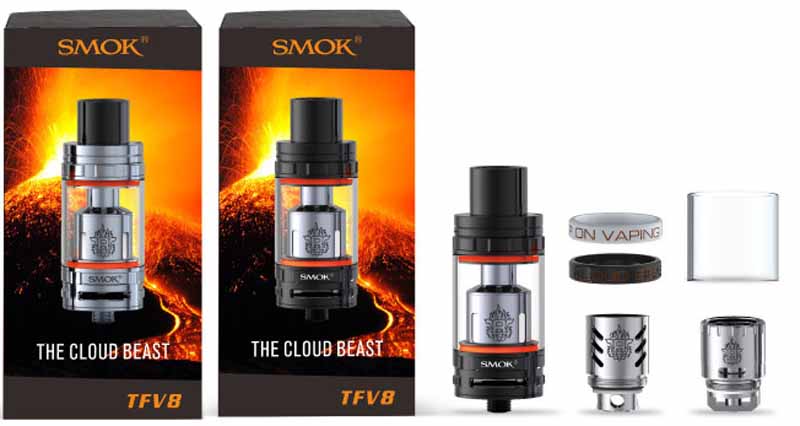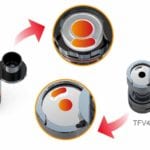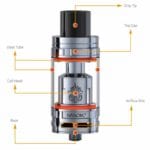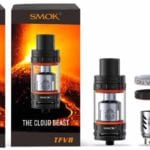Cloud capable

The new Smok TFV8 might be one of the best sub-ohm tanks on the market.
By Mike Huml

As with the majority of the most successful vapor products on the market, the TFV8 from Smok doesn’t try to do anything too crazy. The simplest description that can be presented is, “It’s a better TFV4.” As a buyer, one should have a fairly good idea as to what to expect and how it will sell in one’s particular market. Read on to find out what makes the TFV8 different from, similar to and better than the TFV4.
First, the similarities. Both the TFV8 and TFV4 are designed with cloud-chasers and lung hits in mind. Neither are ideal for the mouth-to-lung vaper, and there are better options out there that will result in more satisfied customers. Both tanks feature a 24.5 mm diameter that allows for larger coils, more airflow and more vapor production. As such, both tanks look better on box mods with a little extra room around the 510 connection; the Reuleaux, X Cube and H-Priv are all good options. Both tanks also feature top-filling by way of a top cap that swivels out to reveal the fill hole. Lastly, both tanks require a good amount of power to perform optimally. While one can get away with a 60- to 80-watt device, 100 watts seems to be the minimum in order for the TFV8 to really shine. Of course, if using the included RBA deck, smaller wire can be used to build custom coils that will function better at lower wattage ranges.
Moving on to the differences, the most apparent upgrade is the build quality. Overall, the TFV8 feels and looks markedly more solid than the TFV4. All the pieces of the tank fit together snugly, and the final product is straight as an arrow with no gaps or leaning. The stainless steel is also a bit smoother and more polished, which makes for an overall cleaner and bolder aesthetic compared to its predecessor.
In terms of performance, the TFV8 yet again one-ups the TFV4. The chimney, coils and airflow holes have been widened to allow for a broader range of airflow options. At maximum airflow, the TFV8 feels like a quality RDA, particularly when used with the RBA deck. In addition, this creates the nice side effect of eliminating spitback. While many other sub-ohm tanks implement some form of spitback prevention that ultimately doesn’t work, or makes spitback worse, the TFV8 doesn’t advertise any sort of spitback prevention at all. Yet, because of its widened design and large drip tip, condensed vapor never gets the chance to cling to the airflow and end up in the user’s mouth, even when pulling hard. Regardless of the coil type installed, the TFV8 offers a remarkably smooth draw devoid of any turbulence whatsoever. However, this was tested with thicker liquid. Having been designed to produce massive clouds, it’s assumed that the user will be using e-liquid with a minimum ratio of 30 PG/70 VG. The use of thinner liquids may or may not affect performance.
In addition to enhanced vapor production, flavor has also been improved compared with the TFV4. The TFV4 was notorious for having a long break-in time, but with the TFV8, it’s barely noticeable. Each coil differs slightly, but all of them are wicked with organic cotton, which has quickly become the standard wicking material for the majority of atomizers. Smok has also scaled coil options down from the far too many available for the TFV4 to four varieties for the TFV8, including the RBA head. The kit includes a quad-coil (V8-T4), an octuple-coil (V8-T8) and the RBA head, with a sextuple-coil (V8-T6) available separately. Each coil type is built in parallel for increased surface area. The T6 coil features three separate chambers with parallel coils in each, while the T8 coil is almost identical except that it boasts four separate chambers. The T6 coil has the most restricted airflow out of the bunch, and those seeking the most flavor should choose these coils when replacements are needed. However, for pure vapor production, the T4 coils are king. These heads have one enormous chamber with two separate strands of parallel wire and provide the most airflow. That’s not to say flavor is poor when using the T4 coils. In fact, all the coil options are very similar and differ in only what is emphasized. All three coil varieties have incredible flavor and airflow, yet each is slightly tweaked to offer a choice to cloud-chasers with different preferences. Of course, airflow can always be adjusted via the airflow ring, so between the coil options and adjustable airflow, an infinite number of permutations exist to satisfy every type of cloud-chaser.
TRIED AND TESTED
The RBA deck comes included with the TFV8 and is one of the best rebuildable sections available due to its Velocity-style design. While other sub-ohm tanks try to get creative with their RBA heads, this often leads to subpar performance compared to their respective pre-made coils. Smok uses a tried-and-true design that’s easy to build and performs better than any RTA. Normally, it’s recommended to use a dedicated RTA if exclusively rebuilding, while RBA sections for sub-ohm tanks generally serve as either a fun piece of hardware to tinker with or a last resort when coils are out of stock. That is not the case here. Any vape shop employee should feel comfortable in recommending the TFV8 to anyone looking for a great RTA, even if the customer isn’t interested in ever using replacement heads. The TFV8 RBA head wicks perfectly, can handle larger builds with any type of wire and has equal airflow to the T4 coils and most RDAs. In fact, it comes pre-built with dual fused Claptons with an inner diameter of 3.5 mm. That’s one of the many benefits of the 24.5 mm diameter: The RBA head is approaching the size of a proper RDA build deck. Of course, the increased capacity is a welcome feature as well.
As previously mentioned, both the TFV4 and TFV8 require a high-power device in order to be used to their full potential. Any dual-18650 should do the trick, but it is possible to use lower wattages for a cooler, lighter hit. While the coils are advertised to perform at up to 260 watts, extreme caution should be exercised if attempting this. With a dual-18650 mod, this essentially means that each battery is supplying 130 watts of power. To put this in perspective, imagine the performance, battery strain and battery life one would get while using a 0.15-ohm coil at 130 watts on a single-18650 battery mod. The results would be short-lived, at best. Make sure to use appropriate batteries, and start around 60 to 80 watts before increasing power incrementally until the preferred performance is reached. A power of 260 watts is overkill, resulting in damage to most batteries, short battery life and potentially unsafe conditions overall.
One additional improvement over the TFV4 is the top-fill swivel door. In the past, it was possible to put the TFV4 in a pocket or bag only to have the door swivel unintentionally and leak. The TFV8 reduces this possibility by increasing the tightness of the door, and it even requires the user to press down slightly when closing it. This provides some much-needed tension that keeps the door in place. For extra peace of mind, the TFV8 includes two silicone bands that can help hold the door in place more reliably, as well as help protect the glass in the event that the tank or mod is dropped or tipped over. If the glass somehow does break, the TFV8 comes included with a replacement too.
All in all, the TFV8 from Smok takes all the feedback and criticism from the TFV4 into account and ticks all the boxes in regard to what a sub-ohm tank should be. Not only is this arguably the best sub-ohm tank available, but it’s among the best RTAs as well. Any customer looking for clouds without sacrificing flavor will be pleased, if not surprised, with the TFV8. It’s simple and solid, which serves most vape hardware much better than gimmicks and excessive deviation from the norm. Think of the TFV8 as the Karate Kid of sub-ohm tanks, relying on the quality of the few things it knows well, rather than on an abundance of things it can’t, and shouldn’t, strive to perfect. Things like janky juice flow control, spitback prevention “technology,” shoddy heat dissipation, and unique and complicated rebuilding technique requirements are nowhere to be found here—because they’re not needed and not missed whatsoever. With a smaller pool of coils to choose from (with far less redundancy compared to the TFV4) and a near-perfect RBA deck, the TFV8 will no doubt find its way into the hands of many a cloud-chaser.



